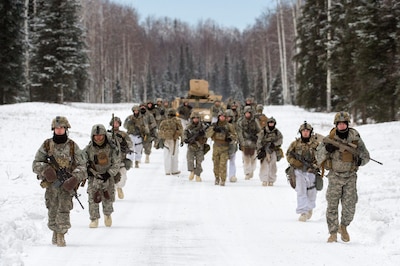By Jim Garamone DoD News, Defense Media Activity
WASHINGTON, March 14, 2018 — The United States already has
the best infantry soldiers, Marines and special operators on the face of the
Earth, but Defense Secretary James N. Mattis wants them to completely overmatch
any potential foes.
Joseph L’Etoile, the senior advisor in the Office of the
Assistant Secretary of Defense for Readiness, is leading a Close Combat
Lethality Task Force to ensure this overmatch becomes a reality.
The task force is laser-focused on capabilities, policies
and doctrine that will allow close-combat squads to overmatch any opposing foe.
“The idea is to ensure a squad can impose its will on a like-sized organization
in any operational environment in any condition,” L’Etoile said in an interview
in his Pentagon office.
A career infantry Marine, L’Etoile is working with Army,
Marine Corps and special operations personnel to examine every aspect of
infantry operations. This effort is aimed at the roughly 130,000 Defense
Department personnel who engage in close-combat operations. This group
historically suffers 90 percent of war casualties.
Improving Squad Lethality and Protection
Many things can be done to improve squad lethality and
protection, L’Etoile said. “There’s some low-hanging fruit, there’s some that’s
going to be a lot of work. There’s some that is futuristic,” he added. “In some
areas, we are going to plant seeds that others are going to harvest.”
Over the last 30 years, most of the changes in infantry
squads have been evolutionary, he said. He pointed to the first night-vision
goggles he used in the late 1980s as an example. “The NVGs that are out there
today are eye watering with the capabilities they have,” he said. But those are
evolutionary changes. “What we’re also looking for are breakout capabilities – more revolutionary
than evolutionary,” he said.
Infantry personnel are still shooting 5.56 mm rounds out of
an M-4 rifle, which is a derivation of the Vietnam era’s M-16. “There is an
element of this that bears repeating — first do no harm,” L’Etoile said. “We
produce magnificent infantry that have been very successful. What we are
looking at is, ‘What is technologically available today that will have a
revolutionary impact?’ This is about optimizing for success.”
Training, human performance and manpower policy are three
nonmaterial aspects that the task force will examine. “A good guideline is
[that] it is what is in the soldier or Marine, not what is on the soldier or
Marine, that is much more important,” he said. “Human performance enhanced by
modern training techniques is what we are looking at.”
The task force is looking at weaponry that has greater range
and lethality and the ability to find and defeat concealed enemy forces. “The
material components are there – they are in the sensing arena. What can we give
a squad that can look over the next ridge line -- and the one after that --
that is man portable?” he said.
Lightening the Load
This last is crucial, he said, as the task force does not
want to add any more weight; in fact, it wants to decrease the warfighter’s
load. A fully equipped infantry soldier carries weapons, water, ammunition,
batteries, food, personal protective equipment, hand grenades, goggles and
more. The weight easily tops 120 pounds. “The piece about reducing the
soldier’s load is central to what we’re looking at,” he said. “There’s some
opportunity there, but there are some technological challenges.”
The task force is looking at what exoskeletons can
accomplish and is considering the possibility of autonomous robots carrying
gear, food and ammunition.
Not all battles occur in the same clime or place. Combat in
cities requires different equipment, sensors and weapons than combat in the
desert or jungle or tundra or forest, L’Etoile said. These environmental
challenges need to be factored into how military officials design, experiment
and procure these capabilities.
One of the innate advantages American squads enjoy is the
innovative spirit. Soldiers and Marines take the initiative to find new ways to
use equipment, capitalize on new technology or use old technology in new ways.
“When they come up with a solution, we have to listen, and
we have the mechanisms in place to exploit that creativity,” L’Etoile said. “We
have a bias for action on the task force. We are not going to let ‘perfect’ be
the enemy of ‘good enough.’”









No comments:
Post a Comment